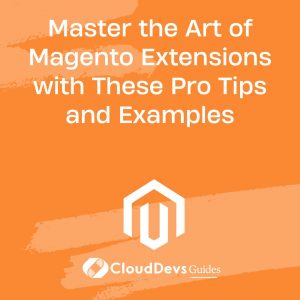Master the Art of Magento Extensions with These Pro Tips and Examples
Magento, as one of the leading e-commerce platforms in the world, provides an extensive ecosystem for developers to create and enhance their capabilities via extensions. Extensions can cater to a wide range of functionalities, from integrating third-party systems and providing advanced analytics to adding custom features specific to a store’s requirements. However, developing Magento extensions require a keen understanding of best practices to ensure compatibility, security, and performance. This blog post will delve into some of these best practices with illustrative examples.
1. Follow the Magento Coding Standards:
Magento has its set of coding standards which every developer should adhere to. These standards ensure that your code remains consistent with Magento’s core code, making it easier for others to read, understand, and collaborate.
Example:
Instead of:
```php
function get_price($product)
{
$price=$product->getPrice(); return $price;
}
```
Use:
```php
public function getPrice(Product $product): float
{
return $product->getPrice();
}
```
Notice the clear method naming, type hinting, and code structure.
2. Avoid Core Code Changes:
Direct modifications to Magento’s core code can lead to issues during updates and potential conflicts with other extensions.
Example:
If you want to change the way prices are displayed, don’t modify the core `Price.php`. Instead, use preference or plugins to alter its behavior.
3. Use Dependency Injection:
Magento 2 introduces the concept of dependency injection (DI) which promotes better software design and decouples your code.
Example:
Instead of directly creating an object:
```php $object = new MyClass(); ```
Use DI:
```xml
<type name="Vendor\Module\Class\Name">
<arguments>
<argument name="myClass" xsi:type="object">Vendor\Module\Class\MyClass</argument>
</arguments>
</type>
```
4. Utilize Events and Observers:
Magento provides an event-driven architecture which can be leveraged to implement custom logic without modifying core code.
Example:
To add a custom action after a product is saved:
```xml
<event name="catalog_product_save_after">
<observer name="custom_action" instance="Vendor\Module\Observer\CustomAction" />
</event>
```
5. Ensure Compatibility:
Ensure your extension is compatible with different Magento versions and doesn’t conflict with popular extensions.
Example:
Test your extension on the latest Magento release and a couple of previous versions. Also, run it alongside popular extensions like `Amasty Improved Layered Navigation` or `Aheadworks Automatic Related Products` to ensure there’s no conflict.
6. Prioritize Security:
Sanitize input, validate data, and ensure that your code doesn’t introduce vulnerabilities.
Example:
When fetching data from a user form, always validate and sanitize it before processing.
```php
$productId = (int) $this->getRequest()->getParam('product_id');
```
7. Use Magento’s Built-In Logging System:
Instead of using `echo` or `print_r` for debugging, use Magento’s logger.
Example:
```php
$this->_logger->debug('Debugging my extension.');
```
8. Create Comprehensive Documentation:
Every Magento extension should come with clear documentation detailing its installation, configuration, and usage.
Example:
Provide step-by-step installation guides, screenshots for backend configurations, and use-cases to help store owners understand the utility of your extension.
9. Provide a User-Friendly Backend:
If your extension requires backend configuration, ensure it’s intuitive and user-friendly.
Example:
Use tooltips, dropdowns with descriptive options, and meaningful labels. If providing a grid view, ensure there are filters, search, and mass-action capabilities.
10. Regularly Update and Test Your Extension:
With every Magento update, test your extension and provide updates if necessary. Regularly check for reported bugs and address them promptly.
Example:
Upon the release of a new Magento version, run your extension, check for deprecated functions, and test for any anomalies.
Conclusion
Developing a Magento extension can be a rewarding endeavor, opening your solution to thousands of merchants around the world. By adhering to the best practices highlighted above, not only do you ensure that your extension seamlessly integrates with Magento but you also cultivate trust with store owners who can confidently use your extension without worry. Always prioritize quality, security, and user experience, and the Magento community will surely appreciate and recognize your contributions.
Table of Contents







